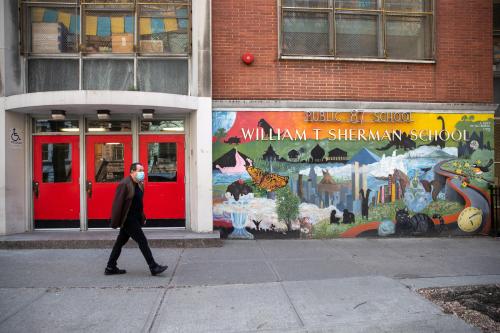This Chalkboard post from May 2020 draws on historical data and past research to forecast the possible impact of COVID-19 school closures on student achievement. With actual data from the 2020-21 school year now available, please see this December 2020 Chalkboard post for an updated analysis of this trend.
Virtually all K-12 students in the United States are currently missing face-to-face instruction due to COVID-19. Many parents and educators thus share a common worry: When the pandemic subsides, kids will return to school with lower achievement. There are also concerns that the gap between high- and low-achieving students will become larger. Given the need to address these concerns, we decided to use prior test scores from millions of students and leverage research on summer learning patterns to make informed projections of what learning loss due to the pandemic might look like. Ultimately, we wanted to know: What sort of learning losses could we expect from the shortened 2019-20 school year?
Answering this question is complicated by the unique circumstances of COVID-19. Current school closures have added to the time that most students already spend at home during the summer months without explicit face-to-face instruction from teachers. Meanwhile, teachers are scrambling to adapt content for an online platform and parents are juggling work responsibilities (if not joblessness) with caring for and educating their own children. Students themselves are faced with isolation, anxiety about a deadly virus, and uncertainty about the future. In so many ways, the current situation is unprecedented for most people alive today.
Yet there are parallels between the current situation and other reasons students miss school that can give us insight into how COVID-19 may affect achievement. This includes research on the effects of out-of-school time on learning due to absenteeism, weather-related school closures (e.g., Hurricane Katrina in New Orleans), and summer vacation. Existing evidence can provide a rough sense of how time out of school due to COVID-19 will affect achievement.
We relied heavily on past precedent when trying to understand how COVID-19 might impact achievement in the short and medium term. We used a national sample of over 5 million students in grades 3-8 who took MAP Growth assessments in 2017-2018. These assessments enable such estimates because MAP Growth is administered multiple times per year, which means test scores are available in fall, winter, and spring such that changes in achievement during the year can be understood and anticipated. We compared typical growth for students who completed a standard-length school year to projections under multiple scenarios. These scenarios were directly informed by out-of-school-time research.
The results are deeply concerning.
The two figures below show projected math and reading learning patterns from the beginning of the 2019-20 school year (before COVID-19 school closures) through the start of the 2020-21 school year. The solid lines represent average trajectories in a typical year with typical growth (estimated based on a prior year’s data) followed by normal patterns of learning loss over the summer (generally, student achievement/learning tends to decline during the summer, though this varies greatly by student). Next, we assume an extended summer loss would occur during the period since schools closed. We refer to this scenario as the “COVID Slide” (represented by the dotted lines). These projections give a sense of how much learning students could lose, though we hope they will be overestimations of loss, given the online instruction and home schooling occurring.
These preliminary COVID Slide estimates suggest students could begin fall 2020 with roughly 70% of the learning gains in reading from the prior year relative to a typical school year. In mathematics, students may show even smaller learning gains from the previous year, returning with less than 50% of the gains. In lower grades, students may be nearly a full year behind in math compared to what we would observe in normal conditions.
Though not shown in the figures, we produced similar estimates of learning loss based on research showing the effect of being absent on achievement. That is, we simply assumed students’ learning during COVID-19 school closures would be akin to what occurs when students miss school, a large assumption given the online learning and homeschooling now occurring. Results for absenteeism-based projections were often more dire.
We also examined how much more variable achievement might be in the fall—that is, how wide the range in achievement might be between very high and very low-performing students. This range has implications for whether teachers can provide similar content to all students in their classrooms, or if they might need to further differentiate instruction based on a broader range of needs.
The above figures show our estimate of that variability by subject for 4th and 6th grade. The shaded areas display the spread in potential outcomes between students who were in the 25th percentile of summer learning loss (who showed steep declines) and those in the 75th percentile (who showed flat lines or even small gains during the summer). In mathematics, we see a fair amount of variability in learning rates, though the majority of students show losses over the extended closure and summer period. However, in reading, there is an even wider spread of potential outcomes, with students who are in the 75th percentile and above showing sizable learning gains during the summer. Further, the figure below shows that extended time out of school may lead to more variability in achievement when students return in the fall relative to a typical year. A wider range of learning needs like the ones suggested by the figure could create greater challenges for teachers.
The New York Times warns that today’s students could be the “COVID generation.” As we think through our road to recovery, we hope education leaders consider our projections among many data points when preparing to support students returning in the fall. Specifically, our results indicate that:
- Students may be substantially behind, especially in mathematics. Thus, teachers of different grade levels may wish to coordinate in order to determine where to start instruction. Educators will also need to find ways to assess students early, either formally or informally, to understand exactly where students are academically.
- Students are likely to enter school with more variability in their academic skills than under normal circumstances. Therefore, educators may need to consider ways to further differentiate instruction or provide opportunities for individualized learning.
- Students who lose the most during the summer tend to gain the most when back in school, but this may not hold for COVID-19. Regardless, the ground that students have to make up during the 2020-21 academic year will probably be greater due to COVID-19. Therefore, educators may want to work with students to determine growth rates needed to catch up and set learning goals for the year that are ambitious but obtainable.
Finally, the effects of COVID-19 our study cannot examine may be the ones most worthy of addressing. Prior research on students displaced by Hurricane Katrina indicated that they had difficulty concentrating and often manifested symptoms of depression in the months following the hurricane. Understanding these impacts and how best to support students’ social and emotional needs after the huge disruption of COVID-19 will be essential. Many students may face greater food insecurity, loss of family income, loss of family members to the coronavirus, and fear of catching the virus themselves.
While the scale of the COVID-19 school closures is novel, the inequalities in our school systems are unfortunately anything but new. Our models cannot account for the reality that the crisis is having an unequal impact on our most underserved communities. Nonetheless, we hope these analyses, which synthesize what we know from existing bodies of research, will inform tomorrow’s decision-making.












Commentary
The impact of COVID-19 on student achievement and what it may mean for educators
May 27, 2020